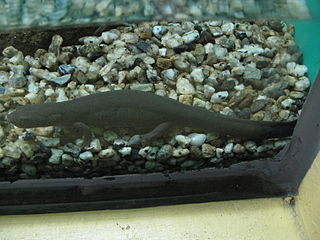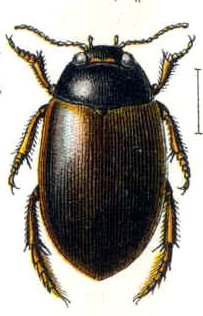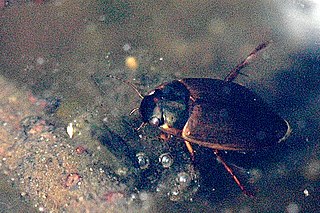
The Callitrichidae are a family of New World monkeys, including marmosets, tamarins, and lion tamarins. At times, this group of animals has been regarded as a subfamily, called the Callitrichinae, of the family Cebidae.

Agabus was an early follower of Christianity from Syria mentioned in the Acts of the Apostles as a prophet. He is traditionally remembered as one of the Seventy Disciples described in Luke 10:1–24.

The tamarins are squirrel-sized New World monkeys from the family Callitrichidae in the genus Saguinus. They are the first offshoot in the Callitrichidae tree, and therefore are the sister group of a clade formed by the lion tamarins, Goeldi's monkeys and marmosets.

The white-lipped tamarin, also known as the red-bellied tamarin, is a tamarin which lives in the Amazon area of Brazil and Bolivia.

Paramesotriton labiatus is a species of newt in the family Salamandridae. It is endemic to Guangxi, China. In literature prior to 2011, this species may have been confused with Paramesotriton chinensis, Pachytriton granulosus, or Paramesotriton ermizhaoi. This species has several vernacular names, including Unterstein's newt, spotless stout newt, spotless smooth warty newt, Zhao Ermi's smooth warty newt, and paddletail newt.

The wildlife of Tunisia is composed of its flora and fauna. It has 84 species of mammals and 375 species of birds. Tunisia is well documented for its addax and dama gazelle population.

Agabus is a large genus of predatory aquatic beetles in the family Dytiscidae, proposed in 1817 by William Elford Leach and named after Agabus, an early follower of Christianity. The adult beetles are moderate-sized, 5 to 14 mm long. The genus is primarily Holarctic in distribution, with only a few species known from the Afrotropical and Neotropical realms. Three species of Agabus, namely A. clypealis, A. discicollis and A. hozgargantae are endangered according to the IUCN Red List. The division into subgenera is not widely accepted. However, a number of species groups are recognized after the works of David J. Larson and Anders N. Nilsson. The genus is probably polyphyletic or paraphyletic. In a recent study of mitochondrial DNA, Agabus was found paraphyletic with respect to several of the species groups of Platambus, a closely related genus in the tribe Agabini. Lately the taxonomy of the genus has been revised, and some groups of species were transferred from Agabussensu stricto to other genera in the tribe Agabini.
Sternarchogiton labiatus is a species of weakly electric knifefish in the family Apteronotidae. Its species name labiatus comes from the Latin labium, meaning "lip", referring to a distinctive three-lobed structure on its lower lips. S. labiatus is only known from the Tefé River, at a depth of 6–14 m (20–46 ft), and from the lower Rio Negro, in the Amazon River basin. They have been captured from both whitewater and blackwater habitats.

Herodion of Patras has been thought by some to have been a relative (συγγενής) of Saint Paul, as in a greeting Paul calls a Herodion a sungenēs in Romans 16:11. But Paul uses the term συγγενής (sungenēs) for fellow Jews in Romans 9:3. So συγγενής (sungenēs) can mean relative even as broadly as fellow Jew. According to tradition, Herodion of Patras was numbered among the Seventy Disciples and became bishop of Patras, where he suffered greatly. After beating, stoning, and stabbing him; they left him for dead, but St. Herodion arose and continued to serve the Apostles.

Agabus affinis is a species of beetle native to the Palearctic and the Near East. In Europe, it is only found in Austria, Belarus, Belgium, Great Britain including Shetland, Orkney, Hebrides and Isle of Man, Croatia, the Czech Republic, mainland Danmark, Estonia, Finland, mainland France, Germany, Hungary, the Republic of Ireland, mainland Italy, Kaliningrad, Latvia, Lithuania, Northern Ireland, mainland Norway, Poland, Russia except the South, Slovakia, Sweden, Switzerland, the Netherlands, Ukraine, and Italy.

Agabus congener is a species of predatory beetle native to the Palearctic and the Near East. In Europe, it is only found in Andorra, Austria, Belarus, Belgium, Great Britain including Shetland, Orkney, Hebrides and Isle of Man, Bulgaria, Croatia, the Czech Republic, mainland Denmark, Estonia, Finland, mainland France, Germany, mainland Greece, the Republic of Ireland, mainland Italy, Kaliningrad, Latvia, Lithuania, Northern Ireland, North Macedonia, mainland Norway, Poland, Russia, Sardinia, Slovakia, mainland Spain, Sweden, Switzerland, the Netherlands and Ukraine.

Agabus melanarius is a species of beetle endemic to Europe, where it is only found in Austria, Belgium, Bosnia and Herzegovina, Great Britain, Bulgaria, the Czech Republic, mainland Denmark, Estonia, Finland, mainland France, Germany, Hungary, mainland Italy, Kaliningrad, Lithuania, Luxembourg, mainland Norway, Poland, Russia except in the East, Sardinia, Slovakia, Sweden, Switzerland, the Netherlands, Ukraine and Yugoslavia.

Agabus striolatus is a species of beetle endemic to Europe, where it is only found in Austria, Belarus, Belgium, Great Britain including Shetland, Orkney, Hebrides and Isle of Man, Croatia, the Czech Republic, mainland Denmark, Estonia, Finland, mainland France, Germany, Hungary, mainland Italy, Latvia, Lithuania, Poland, Russia except in the East, Slovakia, Sweden, the Netherlands and Ukraine.

Agabus sturmii is a species of beetle native to the Palearctic and the Near East. In Europe, it is only found in Austria, Belarus, Belgium, Bosnia and Herzegovina, Great Britain including Shetland, Orkney, Hebrides and Isle of Man, Bulgaria, Croatia, the Czech Republic, mainland Denmark, Estonia, Finland, mainland France, Germany, Hungary, the Republic of Ireland, mainland Italy, Kaliningrad, Latvia, Lithuania, Luxembourg, Northern Ireland, North Macedonia, mainland Norway, Poland, Russia, Slovakia, Slovenia, mainland Spain, Sweden, Switzerland, the Netherlands and Ukraine.

Agabus uliginosus is a species of beetle native to the Palearctic, including Europe, where it is only found in Austria, Belarus, Belgium, Great Britain including Shetland, Orkney, Hebrides and Isle of Man, Croatia, the Czech Republic, mainland Denmark, Estonia, Finland, mainland France, Germany, Hungary, Iceland, mainland Italy, Kaliningrad, Latvia, Lithuania, Luxembourg, mainland Norway, Poland, Romania, Russia, Slovakia, Slovenia, Sweden, Switzerland, the Netherlands, Ukraine and Yugoslavia.

Agabus undulatus is a species of beetle native to the Palearctic, including Europe, where it is only found in Albania, Austria, Belarus, Belgium, Bosnia and Herzegovina, Great Britain including Shetland, Orkney, Hebrides and Isle of Man, Bulgaria, Croatia, the Czech Republic, mainland Denmark, Estonia, mainland France, Germany, Hungary, mainland Italy, Kaliningrad, Latvia, Lithuania, Luxembourg, mainland Norway, Poland, Russia, Slovakia, Slovenia, Sweden, Switzerland, the Netherlands, and Ukraine.
Eero Endjärv is an Estonian architect.

Illimar Truverk is an Estonian architect.
Habib the Carpenter, or Habib Al-Nadjar, حبيب النجـّار, was a martyr who lived in Antioch at the time of Jesus Christ. In Muslim tradition, Habib believed the message of Christ's disciples sent to the People of Ya-Sin, and was subsequently martyred for his faith. The Mosque of Habib-i Neccar, below Mount Silpium, contains the tomb of Habib along with that of Sham'un Al-Safa. Some sources have identified Habib with Saint Agabus of the Acts of the Apostles, an early Christian who suffered martyrdom in Antioch at the time of Jesus. This connection is disputed, as Christian tradition holds that Agabus was martyred at Jerusalem, and not at Antioch as Muslims believe of Habib. All Muslim sources list Habib's occupation as a carpenter.















